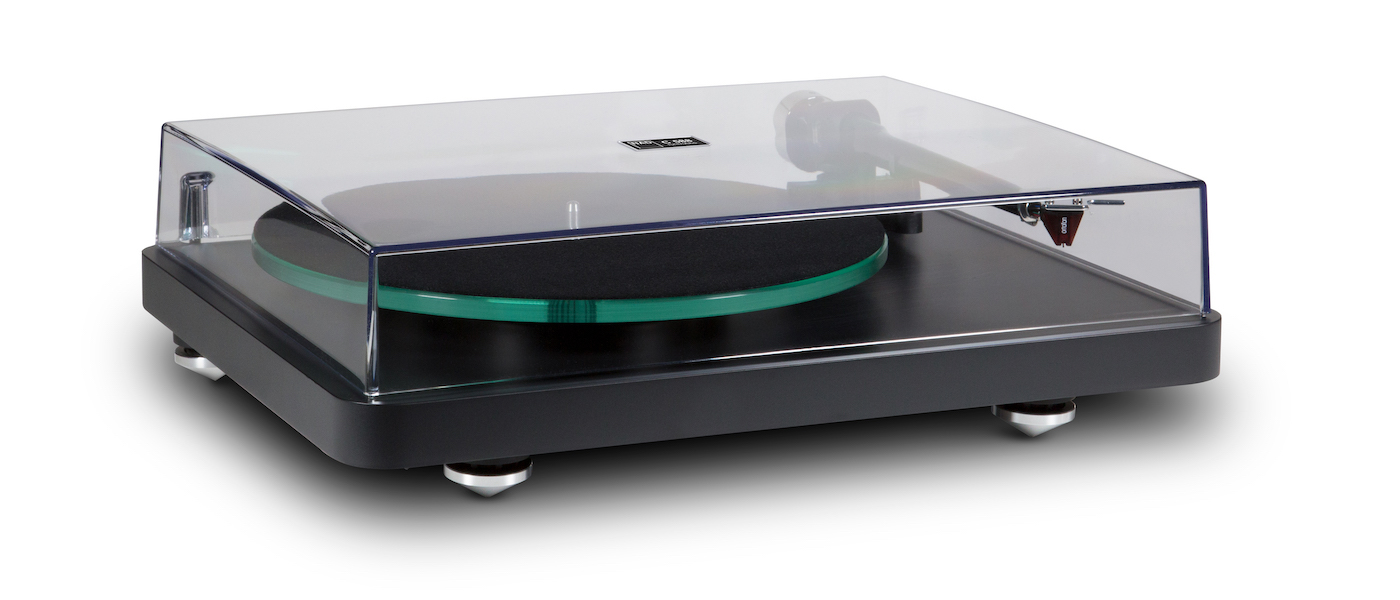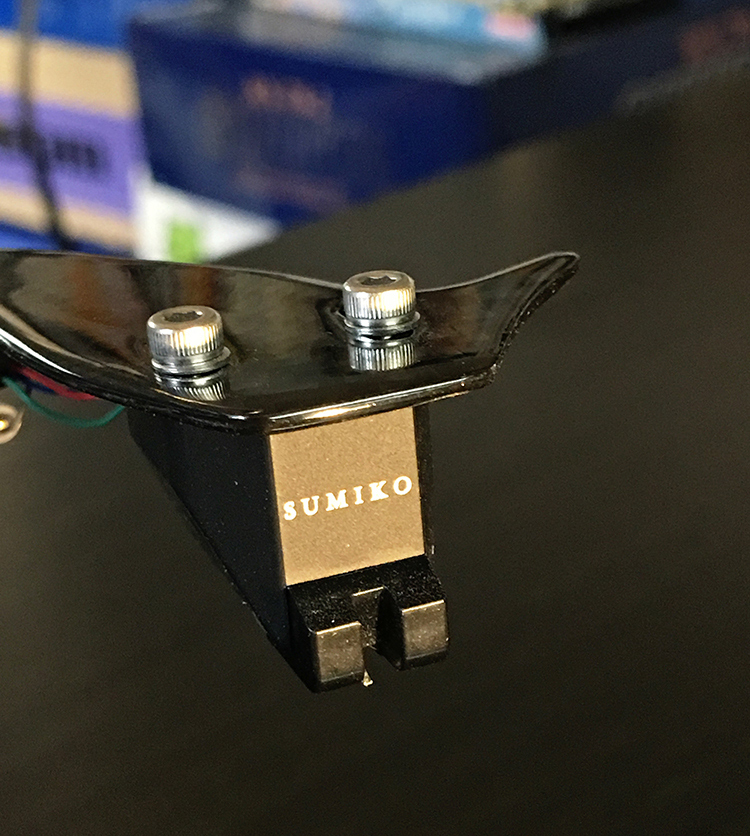
Beyond its good looks, it features all the adjustments a vinyl lover would need to get the most out of their music collection. My review sample came fitted with a Sumiko Amethyst cartridge.
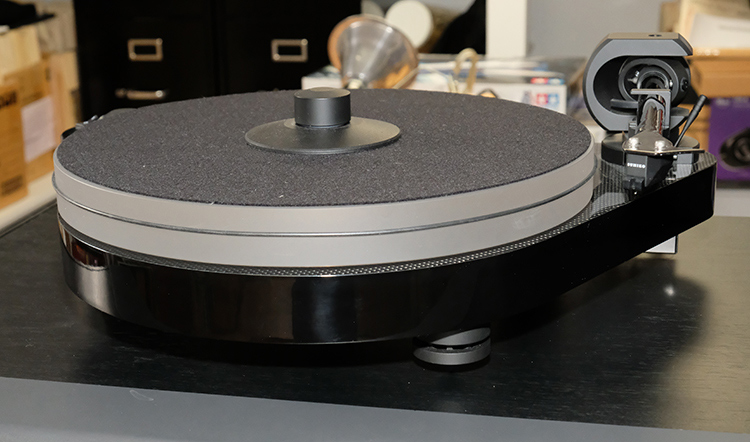
Pro-Ject RPM 5 Carbon Turntable – Front view
Pro-Ject RPM 5 Carbon Turntable
- Very unique and stylish design.
- Thick acrylic platter.
- One-piece carbon fiber tonearm and headshell.
- VTF, anti-skate, azimuth and VTA adjustments are all available.
- Comes with Sumiko Amethyst MM cartridge pre-installed with factory set up.
- The outboard motor is unusual at this price.
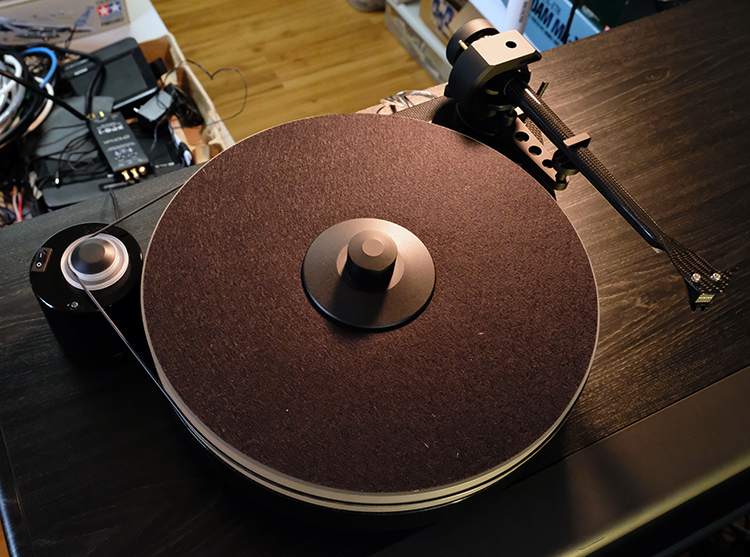
Pro-Ject RPM 5 Carbon Turntable – Top view
Pro-Ject Audio has been around since 1991 and has developed a very deep portfolio of turntables ranging from the introductory to the ultimate with some fun and innovative “special edition” turntables sprinkled in for good measure. The RPM line contains five turntable models with the RPM 5 Carbon parked squarely in the middle of the pack. Sporting unique features like a carbon fiber tonearm, a completely detached and isolated drive motor and a bundled Sumiko MM cartridge, this great looking table looks to provide a lot of value for the asking price. Let’s see how it delivers.
Pro-Ject RPM 5 Carbon Turntable
Design:
Belt Drive Turntable with tonearm and cartridge
Speeds:
33 and 45 rpm via changing belt position
Wow & Flutter:
33 RPM: +/- 0.12%, 45 RPM: +/- 0.10% (manufacturer)
Downforce Range (VTF):
0 – 25 mN
Tonearm Length:
9-inches
Tonearm Mass:
8 grams
Plinth:
MDF with a carbon fiber layer
Main Bearing:
Stainless steel axle with ceramic ball
Platter:
300 mm Acrylic
Tonearm Design:
9” CC EVO Carbon Fiber
Arm Bearing:
Gimbal
Built-In Phono Preamp:
None
Supplied Cartridge:
Sumiko Amethyst, Moving Magnet
Accessories:
Dust Cover, Counterweight, Counterweight Insert, Record Clamp, Braided Interconnect Cables with integrated ground wire, 45 rpm adapter, Allen wrenches, Cartridge Alignment Gauge, VTF Gauge, Head-shell Spacer, Power Supply, Cleaning Cloth
Colors:
Gloss Black, Gloss White, Gloss Red
Dimensions:
18.1” W x 13.9” D x 5.6” H (with dust cover closed)
Weight:
18.7 pounds
MSRP:
$1595.00 (including cartridge)
Company:
Sumiko Amethyst Cartridge
Design:
Moving Magnet Phono Cartridge
Stylus Tip:
Nude Line Contact Diamond tip
Stereo Output:
2.5 mV @ 1 kHz
Frequency Response (Manufacturer):
12 Hz – 35 kHz
Channel Separation (Manufacturer):
30 dB @ 1kHz
Recommended Tracking Force:
1.8 – 2.2 grams (2.0 grams recommended by Sumiko)
Recommended Resistance Loading:
47 kOhms
Recommended Capacitance Loading:
100-200 picofarads/channel (includes tonearm wiring and phono preamp input capacitance)
Cartridge Height:
19.0 mm
Weight:
6.5 grams
Company:
SECRETS Tags:
Pro-Ject, Turntable, Audiophile, Tonearm, Turntable Reviews 2019
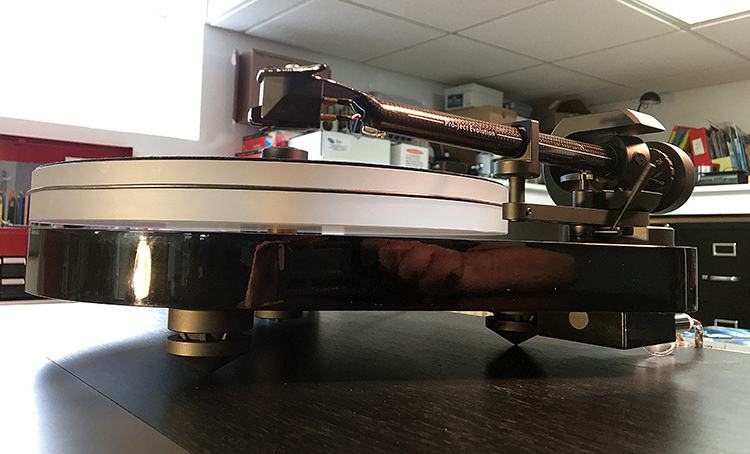
Pro-Ject RPM 5 Carbon Turntable – ¾ view
The Pro-Ject RPM 5 Carbon turntable is certainly one of the more unique looking platter-spinners that I have had in for review. It is one step below the RPM 9 model that Secrets Editor-in-Chief John E. Johnson Jr. has previously reviewed last year. I would highly recommend that readers take a perusal through John’s review as it contains a very thorough step-by-step setup guide for the RPM 9 that can be applied verbatim in setting up the RPM 5.
The first thing you notice about the RPM 5 Carbon is the drive motor is completely separated from the turntable chassis. The drive belt alone is the only thing that connects the motor to the turntable. Thankfully the 15 Volt DC powered motor itself is quite heavy and it sits in its own weighted metal stand with three rubber feet. This ensures that it remains stationary once the whole motor-belt-platter connection is properly configured. Pro-Ject includes a handy clear plastic guide/template that allows proper motor positioning from the platter.
Speaking of the platter, it is a heavy and thick frosted acrylic piece that sits squarely over a dense MDF plinth of equal diameter, save for a little peninsula that juts out where the tonearm is mounted. The plinth itself, on my review sample, is finished in a lovely gloss black with a carbon fiber trim layer on top. The whole shebang rests on three large adjustable feet with rubber tips.
The RPM 5’s tonearm is a 9-inch long carbon fiber wand with integrated cartridge mount. The material’s appearance not only makes the tonearm look striking but it’s inherent lightness and rigidity is properly suited for this application. The wand also has an internal magnet that works with the magnetized armrest keeping the tonearm securely docked when not in use.

Pro-Ject RPM 5 Carbon Turntable – Motor
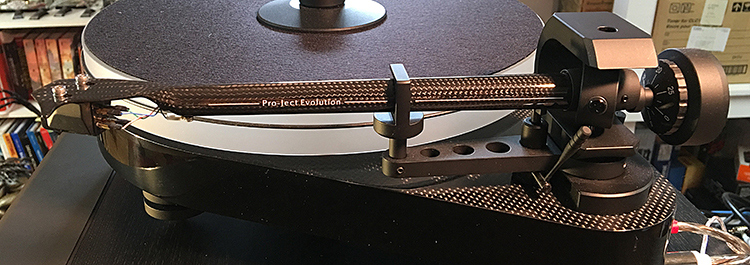
Pro-Ject RPM 5 Carbon Turntable – Tonearm side view

Pro-Ject RPM 5 Carbon Turntable – Tonearm top view
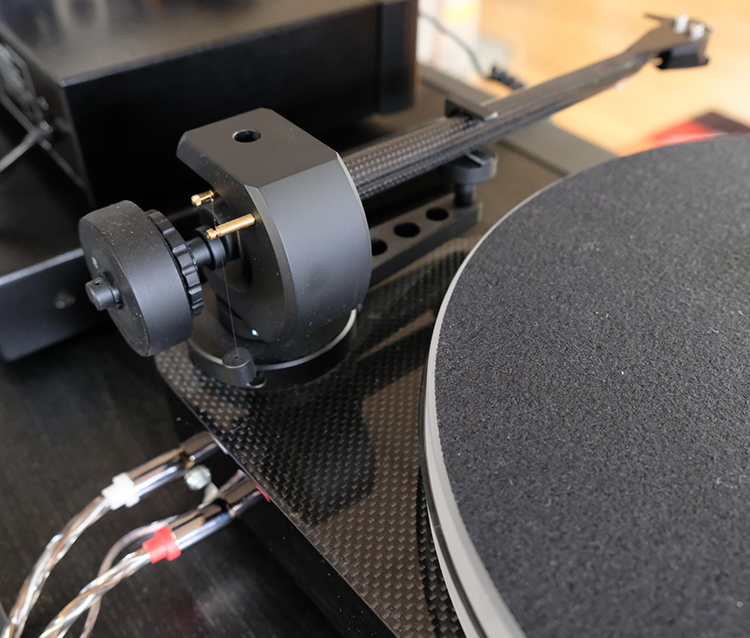
Pro-Ject RPM 5 Carbon Turntable – Tonearm anti-skate
The RPM 5’s tonearm features integrated adjustments for VTA, VTF, anti-skate, and azimuth. Some of these had been preconfigured at the factory along with the cartridge mounting. A little quick verification showed that VTA and azimuth were correct, I simply needed to set up the VTF and the anti-skating counterweights appropriately. The bearings used in the pivot point of the tonearm provided very smooth movement in the horizontal and vertical planes with no resistance that could be felt.

Pro-Ject RPM 5 Carbon Turntable – Output Jacks
The RPM 5 Carbon has no built-in phono preamp and has separate RCA jacks and a grounding lug so that owners can use cables of their choice. The table does come with a rather nice set of braided cables possessing an integrated grounding wire which looked good and worked perfectly well.
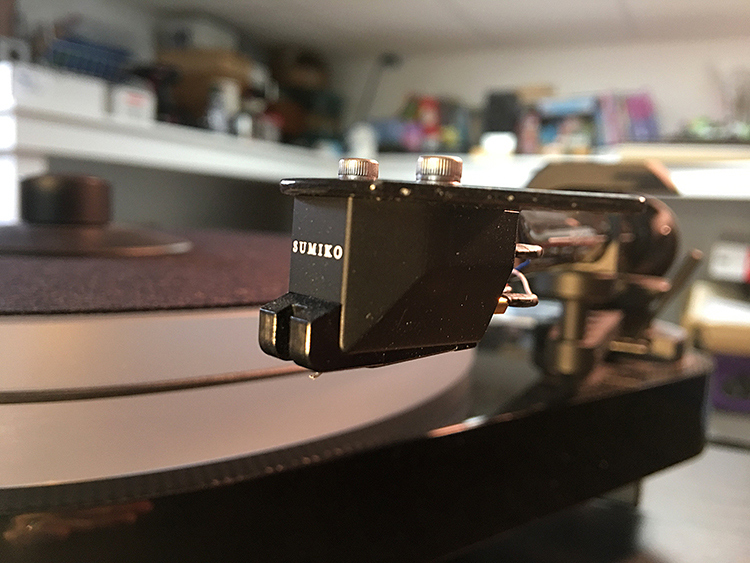
Pro-Ject RPM 5 Carbon Turntable – Cartridge ¾ view
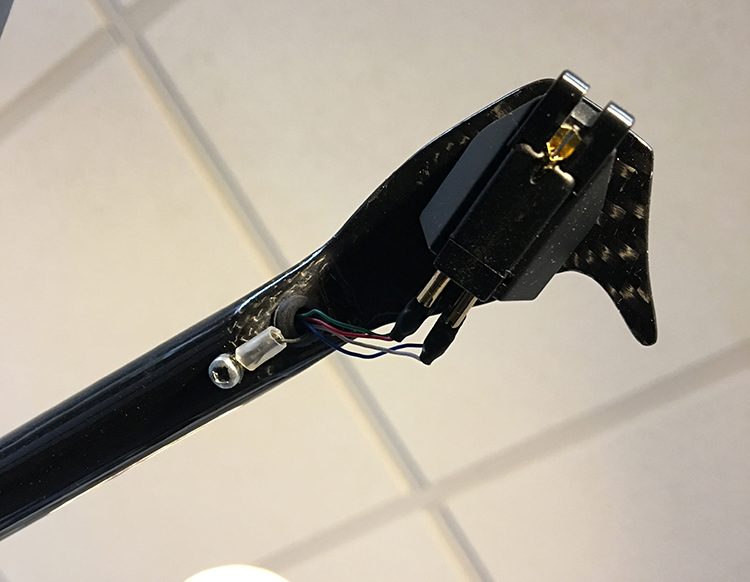
Pro-Ject RPM 5 Carbon Turntable – Cartridge underneath view
The review turntable came with a Sumiko Amethyst, Moving Magnet phono cartridge pre-installed. The Amethyst is a newer cartridge in Sumiko’s Oyster series. It features a nude, line contact diamond stylus on an aluminum cantilever. Purchased on its own, the Amethyst costs $599.00.
The turntable does not come with a lid, but one is available as an optional extra.
For this review, the connected components consisted of: Paradigm Persona 7F loudspeakers, the Revel F228Be loudspeakers (review coming soon), an Anthem STR stereo preamplifier, a Class D Audio SDS-470C Power amplifier (300 watts @ 8 ohm, 600 watts @ 4 ohm), the PASS Labs XP-25 phono preamplifier, a Rotel RQ-970BX phono preamplifier and a Panamax M5500 power conditioner. Speaker wire and interconnect cable are by Blue Jeans Cable.
The cartridge tracking force was set at the recommended 2 grams, while impedance loading was set to 47 kOhm and capacitance loading at 100 picofarads.
Straight away as we unpacked the RPM 5 Carbon, my teenage son insisted that we set up the turntable in his room. Once we got it all together (a fairly easy process) and verified that all the adjustments were correct, my son couldn’t stop gushing over the look of the RPM 5 Carbon. He loved everything about it, the black, the carbon fiber, the unusual separated drive motor, all of it. He was like a kid with a new puppy. A lanky, dreadlocked, 6-foot-tall, metal-head kid mind you! You have to figure that Pro-Ject’s design department is doing something right if they can get a 17-year old male to get all wobbly-in-the-knees over a turntable. He was reviewing the NAD/PSB desktop system at the time, so I agreed to let him use the RPM 5 Carbon in that system for a week until I was done with another review that I was working on. For the next 7 days, the sound of various brands of death-metal was regularly raging from my offspring’s room. I considered it a good break-in period!
Once my son’s time with the turntable was over, I got it transferred to my main studio system and I re-checked all the adjustments. It was obvious that he had babied the turntable since everything was still in perfect order and I couldn’t even find a fingerprint anywhere on the plinth or tonearm. Despite his taste in music, he had treated the RPM 5 Carbon as if he were the James Bond baddie Blofeld gingerly stroking his cat!
My impressions of the RPM 5 Carbon/Sumiko Amethyst combination are generally favorable, but with a few caveats. It should be noted that for subjective analysis, I compared the sound of the Pro-Ject/Sumiko combo to my reference Technics/KAB SL1200 MK 6 table with an Audio-Technica OC9ML/II moving coil cartridge. While the OC9ML/II is an older model (still available but slowly being phased out), it is a fine sounding and performing cartridge and, while slightly less expensive than the Sumiko Amethyst, is a good benchmark to judge other cartridges by. Using the Pass XP-25 dual phono inputs, I attempted to level match the volumes, through the STR preamp, of both turntables using test tones from one of my CBS Labs Test LPs. Over a wide variety of sampled music genres, I found the overall sound of the Pro-Ject/Sumiko pairing to be generally pleasing. It genuinely had good bass control and impact with all types of music that I listened to; it was also apparent that the Sumiko Amethyst had a bit more of a forward presentation than I was used to. This tended to work well with rock, pop, blues, and jazz giving a more immediate feel to the sound. However, when I compared it to my reference setup, there was a noticeable reduction to the size of the soundstage, and I felt the RPM 5/Amethyst combo had less perceived depth to its reproduction. This difference in performance became starker when I specifically switched to classical music. The Sumiko Amethyst still sounded pleasing and seemed to hold it together for casual listening and on less demanding material but, with more critical listening, I consistently heard the smearing of low-level details on some pieces. Things like background cymbals and snare drums had somewhat of a “static” sound quality to them where, in comparison, those same instruments and moments sounded correct through my reference setup. The Sumiko also didn’t do so well when dealing with loud and complex passages that happened to be situated towards the inner grooves of an LP. Something like the finale to the William Tell Overture or segments of Rachmaninoff’s Symphony #2, for example. There were a few times when the tonearm and cartridge noticeably mistracked or produced audible distortion in the inner grooves when the orchestral piece got intense.
Some of the musical selections that I found particularly interesting and enjoyable in my time with the Pro-Ject RPM 5 Carbon Turntable were:
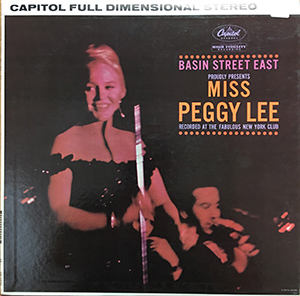
Peggy Lee, Basin Street East, Capitol Records
Peggy Lee, Basin Street East, Capitol Records, ST 1520, 1961. A nice live jazz recording with great atmosphere and vocals. Starting with the track “I Love Being Here with You”, Peggy Lee’s vocals sounded clear and were rendered with excellent body. The general ambiance and reverb of the Basin Street East club came across well but didn’t seem to be as deep as when I listened with my reference Technics/A-T setup. Bass lines were solid and had good delineation throughout, although the drum cymbals and horns had a little bit of an exaggerated sharpness to their sound.
“But Beautiful” is a lovely, intimate song where Miss Lee’s vocals are front-and-center in the performance. The Pro-Ject/Sumiko combo did an admirable job of relaying all of the subtleties and nuance of her vocal inflections. Some of the lower level details like the breaths she took between lyrics were not as clear as I have heard before but otherwise, things sounded pleasing. The accompanying piano and flute both sounded good and smooth in their reproduction. One of Peggy Lee’s most well-known songs “Fever” was performed with sheer confidence and a wry sense of humor before the appreciative crowd. Again, I think the Sumiko Amethyst did not reproduce the depth of the soundstage as well as my Audio-Technica OC9ML/II, as I missed some of the club’s ambiance and some of the finer details in the crowd that I am used to hearing. On the other side of the coin, the bass response was outstanding. The kick drum sounded impactful and the bongos had good weight and much of the skin detail came through as well.
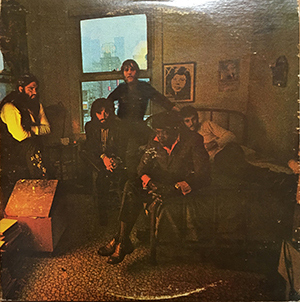
Canned Heat & John Lee Hooker, Hooker ‘N Heat, Liberty Records
Canned Heat & John Lee Hooker, Hooker ‘N Heat, Liberty Records, LST 35002, 1971. Many of my observations of the Pro-Ject/Sumiko pairing on the previous album continued to be relevant on this fantastic blues album. In John Lee Hooker’s solo performance on “Alimonia Blues”, Hooker’s electric guitar sounded more prominent in the performance along with his vocals too. His trademark foot-stomping to keep time also sounded more impactful. All this gave the music a greater sense of immediacy than my reference setup although the reverb of the room did not come across as well as I am used to hearing.
“Driftin’” continues with John Lee Hooker being joined by Canned Heat’s Alan Wilson on harmonica. Wilson’s harmonica playing was perfectly fixed in the center of the image, having a good amount of edge and brightness to its sound without getting too abrasive. Dimensionally, however, the performance came off sounding a little flat overall. “Let’s Make It” brings in the rest of Canned Heat to play with Hooker and it makes for a swinging boogie! John Lee hooker’s singing comes across as bold and potent with the Pro-Ject/Sumiko pairing. Electric guitars and bass also sounded strong and had good presence. But, again, that increased forward sound that I heard, in some respects, seemed to come at a cost of depth and width of the image of the whole band. Things sounded louder but smaller.

Beauty In Chaos, Finding Beauty In Chaos, 33.3 Music Collective
Beauty In Chaos, Finding Beauty In Chaos, 33.3 Music Collective, 2018. Of all the music I played, I felt that the Sumiko Amethyst hit its sweet spot with the sound of Alternative Rock. Overall, the more forward sound quality and its penchant for bass worked well with this double album of well-recorded rock tracks. On “Heliotrope” kick drums and electric bass sounded impressive while Betsy Martin’s vocals had great detail and character to them. I also noticed less of a difference in this music’s general ambiance and soundstage when comparing the Sumiko Amethyst to my reference Audio-Technica cartridge. On the title track “Finding Beauty in Chaos”, Ashton Nyte’s deeper resonant vocals sounded especially good with the Sumiko.
The electric guitars on this track had a very liquid and smooth character to the sound that also came across in a very appealing manner. When I got to the track “The Long Goodbye”, I did pick up that somewhat “static” sounding rendering of the drum cymbals while, conversely, the layering of the electric guitar tracks were easily delineated and heard, each having their own distinct sound. As I’ve mentioned previously, the kick drum here was especially impactful and sounded better than my reference setup.

Music from Walt Disney’s Fantasia, London Phase 4
Stokowski/Camarata/Herrmann/Black, Music from Walt Disney’s Fantasia, London Phase 4, SPC 21076, 1972. This type of album is where the rubber hit the road for this cartridge. While it’s amusing to use passages like the cannon shots from the 1812 Overture to torture test cartridge tracking, it’s more telling to use generally intense and dynamic music, like what is found on this album (and many other classical LPs), to gauge more realistic cartridge/tonearm behavior. It becomes especially critical towards the inner grooves of an LP. Soundstage reproduction was less of an issue on this album due to the multi mic’d nature of London’s “Phase 4” recording process.
In this case it worked in the Sumiko Amethyst’s favor, being more upfront and direct sounding. On some other classical LPs, I heard a greater soundstage disparity between the Amethyst and my reference Audio-Technica, the Sumiko being consistently less wide and deep. On this LP, during “The Sorceror’s Apprentice”, the Sumiko did well in the initial calmer stages of the performance but, as the piece progressed to its finale, the high intensity of the horns caused noticeable distortion while crashing cymbals had a harsh and brittle quality to them, something that my AT cartridge did not exhibit. The strings, in general, were kept in check but there was an unappealing thinness to their sound. While this piece took up the inner grooves of Side 1, “Night on Bald Mountain” is at the beginning of Side 2 and it still exhibited some unpleasant distortion with the horns and cymbals, although not to the same degree as the previous track. The bass drums were impressively authoritative sounding here, but the other audible distortion artifacts lead me to believe that the review cartridge was not entirely happy reproducing this material.
In the end, I suppose it’s going to depend on how discerning a listener you are or what your taste in music is to really tell if you are going to be happy with the Sumiko Amethyst. It’s not a bad cartridge per se, I just don’t think it’s an outstanding one for the money. It’s slightly forward character and good bass reproduction is sure to find favor with some listeners out there. On the other hand, the smaller soundstage and difficulty with intense inner grooves on an LP (particularly on classical material) might turn some potential buyers off. In regards to the turntable, the RPM 5 Carbon is an absolute looker, and its performance was essentially faultless. It always operated smoothly and reliably throughout its time here and got consistent raves for its looks by several guests. If I had one nitpick about it, it’s that the cueing arm doesn’t have the kind of granular control of the tonearm’s position that I’d like. It won’t allow you to bring the tonearm down, say halfway, and then keep it there if you take your finger off the cueing arm. Once you release the cueing arm anywhere in the tonearm’s vertical travel, the tonearm will continue to drop. It just makes cueing up a specific track require a little more attention.
Measurements and Analysis by Carlo Lo Raso and David A. Rich.
While this is a review of the RPM 5 Carbon turntable, the Sumiko Amethyst cartridge is sold with this table, as a set, so it’s performance is integral to the review as they are working as a unit. The Pro-Ject RPM 5 Carbon was connected to a Rotel RQ-970BX phono stage. The output, from the phono stage, was recorded digitally at 24-bit 48 kHz (to minimize groove wear on the test LPs) on a TASCAM HD-P2 digital recorder. Those results were analyzed on my computer using SpectraPLUS audio measurement software via the Lynx TWO B professional sound card. The CBS Labs STR 100 test LP was used to measure frequency response, channel crosstalk, distortion and 100 Hz IM tracking while the STR 112 test LP was used for 200, 300 and 400 Hz lateral/vertical tracking and IM tests. Trackability tests were conducted using the Shure TTR-117 test LP. Measurements were taken with a VTF of 2.0 grams applied to the cartridge as recommended by the manufacturer.

Pro-Ject RPM 5 Carbon /Sumiko Amethyst Blue Frequency Response and Channel Separation
This chart shows the frequency response and channel separation measurements of the RPM 5 Carbon/Sumiko Amethyst combination. While the response remains flat for most of the bass and midrange frequencies, this cartridge runs about 2 dB hot at 20 Hz before flattening out by 50 Hz. The response remains linear until 3 kHz where we begin to progress to a 2 dB dip centered at 5 kHz. At this point, the Left and Right channels diverge whereby the Left trace gets to a 2 DB peak from 12 kHz – 16 kHz before arriving at a 1 dB dip at 20 kHz while the Right trace gets to its 2 dB peak at 16 kHz before meeting up with the Left channel again at 20 kHz. The channel separation components seem to stay pretty close to each other through most of the range.
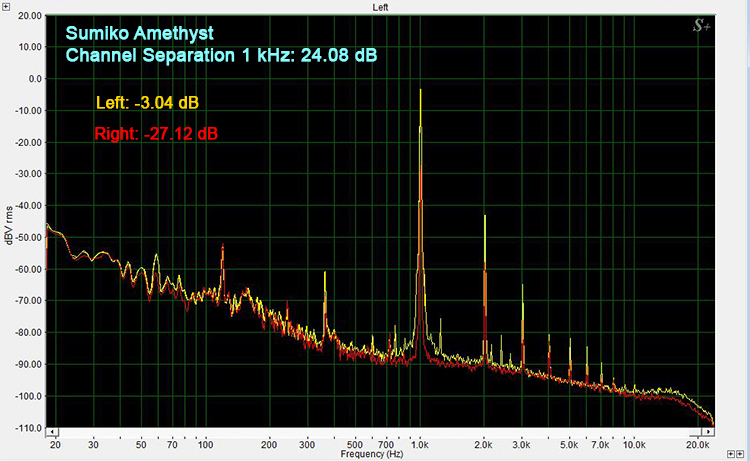
Pro-Ject RPM 5 Carbon /Sumiko Amethyst Blue Channel Separation 1 kHz
The measured channel separation for the Pro-Ject/Sumiko combo at 1 kHz is 24.08 dB. This figure is almost 6 dB less than what Sumiko specs for this cartridge at that frequency. On a side note, spurs at 60Hz, and multiples of that frequency are from power line hum getting into the cartridge. Depending on the design of the cartridge, this can change significantly. The Pro-Ject /Sumiko combination produces well-suppressed power supply harmonic spurs.
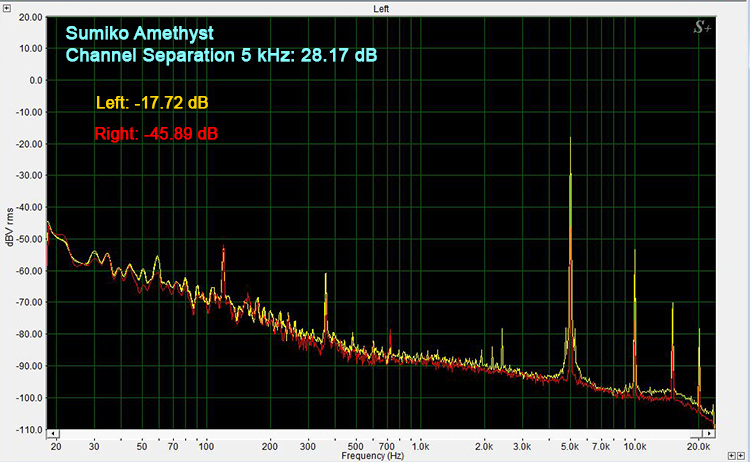
Pro-Ject RPM 5 Carbon /Sumiko Amethyst Channel Separation 5 kHz
The measured channel separation for the Pro-Ject /Sumiko combo at 5 kHz is 28.17 dB. Not bad at all.
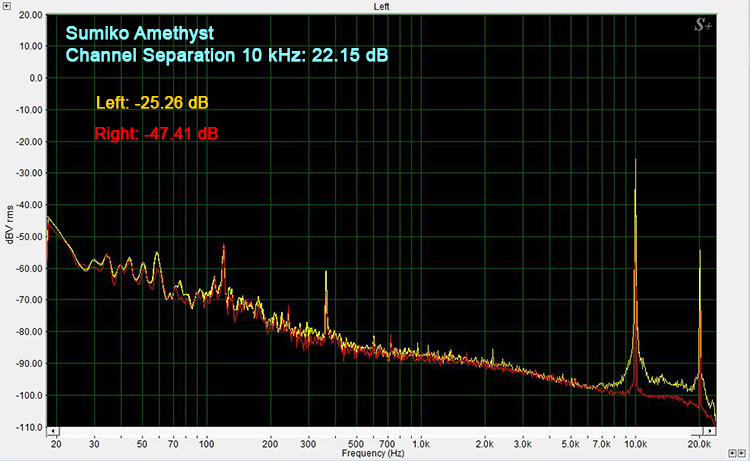
Pro-Ject RPM 5 Carbon /Sumiko Amethyst Channel Separation 10 kHz
The measured channel separation for the Pro-Ject /Sumiko combo at 10 kHz is 22.15 dB.

Pro-Ject RPM 5 Carbon /Sumiko Amethyst Channel Separation 20 kHz
The measured channel separation for the Pro-Ject /Sumiko combo at 20 kHz is 12.69 dB. For a cartridge of this class, this figure should be a little bit better.
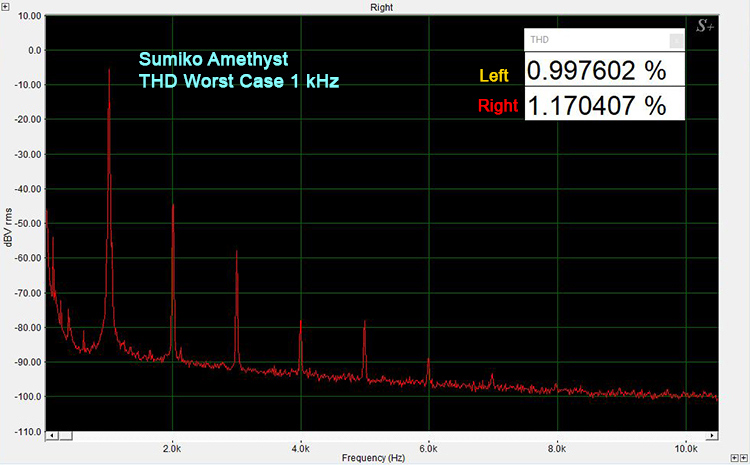
Pro-Ject RPM 5 Carbon /Sumiko Amethyst Worst Case THD 1 kHz
Here is the 1 kHz THD measurement for the Pro-Ject /Sumiko combo. While we show figures for both channels, the higher number is the one that gets reported, hence worst-case. In this instance, it’s the right channel with a THD of 1.17%. While okay for a line contact stylus, this is a little higher than would be preferable.

Pro-Ject RPM 5 Carbon /Sumiko Amethyst Worst Case THD 5 kHz
The 5 kHz THD measurement for the Pro-Ject /Sumiko combo shows a worst-case figure in the right channel of 1.76%. This is worse than average performance for a line contact stylus.
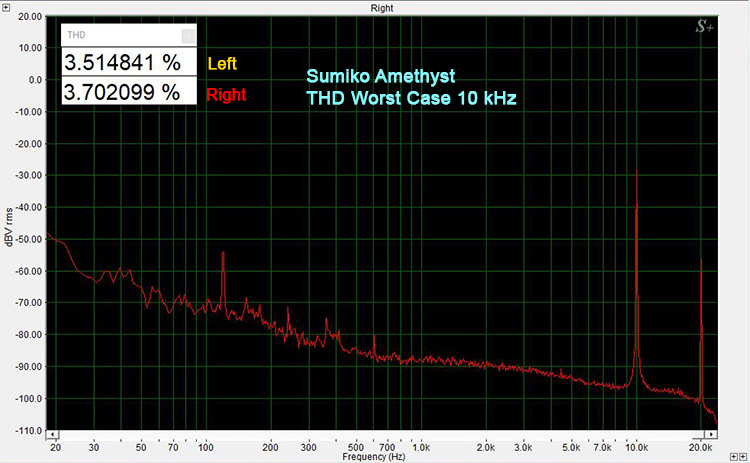
Pro-Ject RPM 5 Carbon /Sumiko Amethyst Worst Case THD 10 kHz
The 10 kHz THD measurement for the Pro-Ject /Sumiko combo shows a worst-case figure in the right channel of 3.70%. This is also worse than average performance for a line contact stylus.
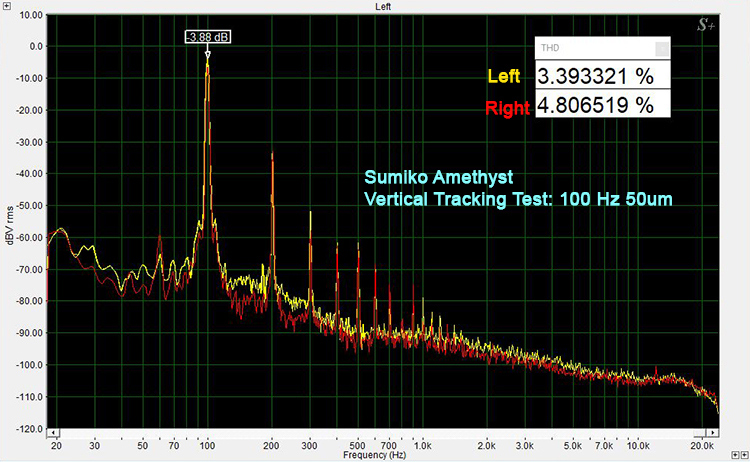
Pro-Ject RPM 5 Carbon /Sumiko Amethyst 100 Hz Vertical Tracking Test 50 um
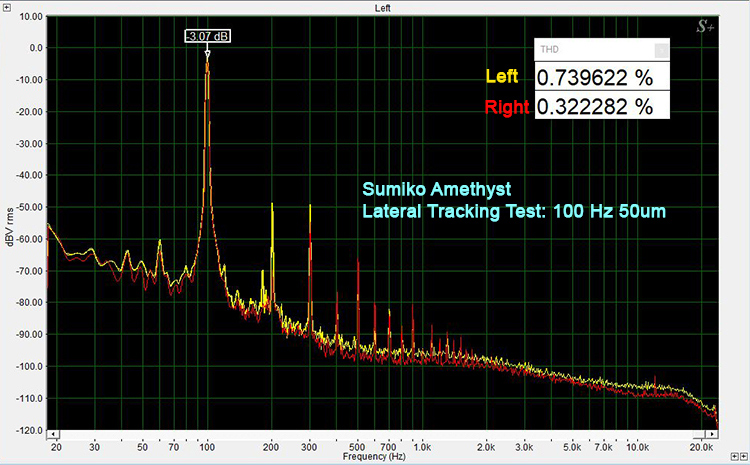
Pro-Ject RPM 5 Carbon /Sumiko Amethyst 100 Hz Lateral Tracking Test 50 um
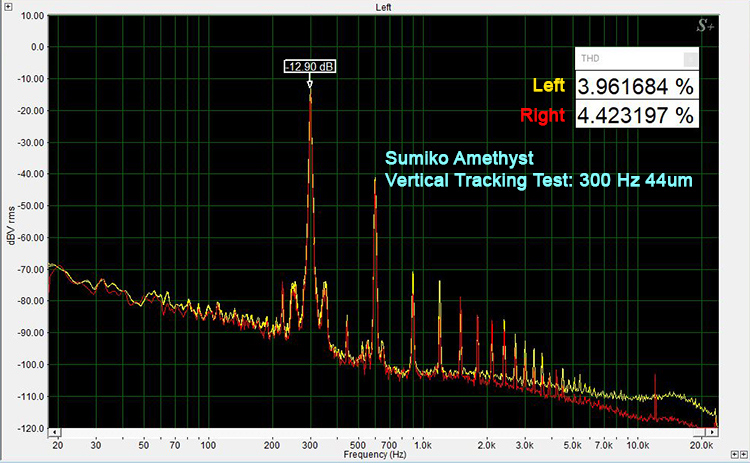
Pro-Ject RPM 5 Carbon /Sumiko Amethyst 300 Hz Vertical Tracking Test 44 um

Pro-Ject RPM 5 Carbon /Sumiko Amethyst 300 Hz Lateral Tracking Test 88 um
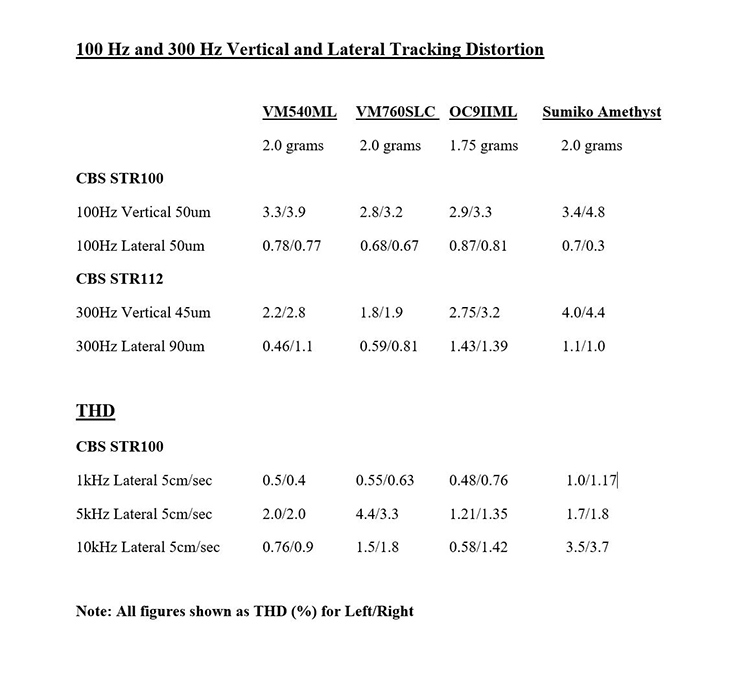
Pro-Ject RPM 5 Carbon /Sumiko Amethyst Tracking Test Data Chart
The above test tones at 100 Hz and 300 Hz use highly modulated grooves to stress-test cartridge distortion and tracking performance in the vertical and lateral plane. As you can see in the spectra, there is plenty of distortion generated beyond the fundamental tone because the cartridge is having difficulty tracking these larger grooves. The chart shows the Sumiko Amethyst’s resulting distortion numbers in relation to other cartridges we have tested.
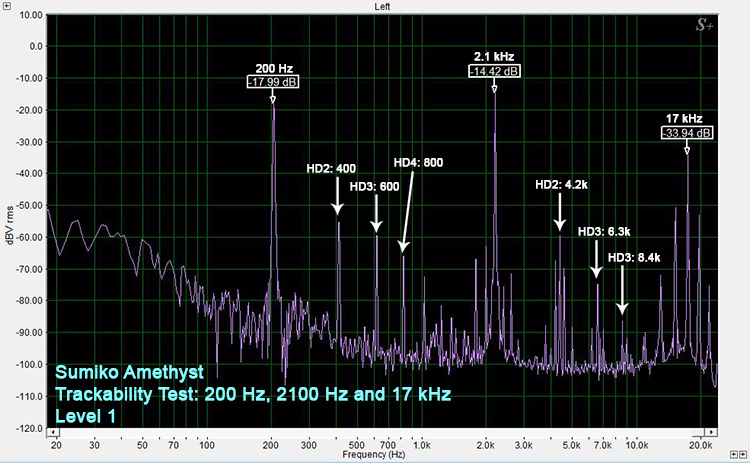
Pro-Ject RPM 5 Carbon /Sumiko Amethyst Trackability Test Level 1
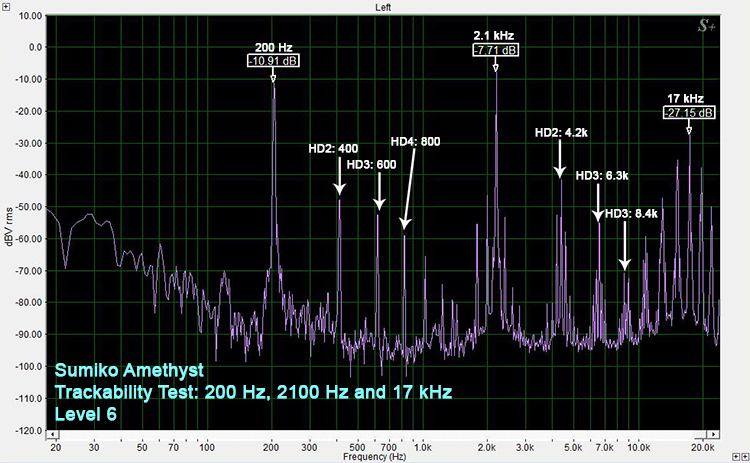
Pro-Ject RPM 5 Carbon /Sumiko Amethyst Trackability Test Level 6

Pro-Ject RPM 5 Carbon /Sumiko Amethyst Trackability Test Data Chart
The Shure TTR 117 tracking test has three tones at 200 Hz, 2.1 kHz, and 17 kHz. The LP has 6 levels with each level increasing in amplitude. Between levels 1-3 the levels increase be 2 dB then the remaining 3 levels are in 1 dB step for a total change of 7 dB. The amplitude of the 3 tones, at a given level, varies. With the RIAA compensation, the 2.1 kHz tone has the highest amplitude. The 200 Hz tone is 4.5 dB lower relative to the 2.1 kHz tone. The 17 kHz tone is 20 dB down relative to the 2.1 kHz tone.
When calculating the IM distortion, we need to pick which amplitude to use as the reference. If we use the highest amplitude as a reference, the percentage of distortion will decrease compared to using the smaller amplitude as the reference. For the values above we used the 2.1 kHz tone amplitude which results in a lower percentage of distortion.
The table above shows the distortion we measured for the Sumiko at levels 1 and 6. For comparison we supply the values we measured from the Audio Technica VM540 which has a Micro Line stylus.
On level 6 the 2.1 kHz THD and 2.1 kHz / 17kHz IM are more than 3 times the values measured with the Micro Line stylus.
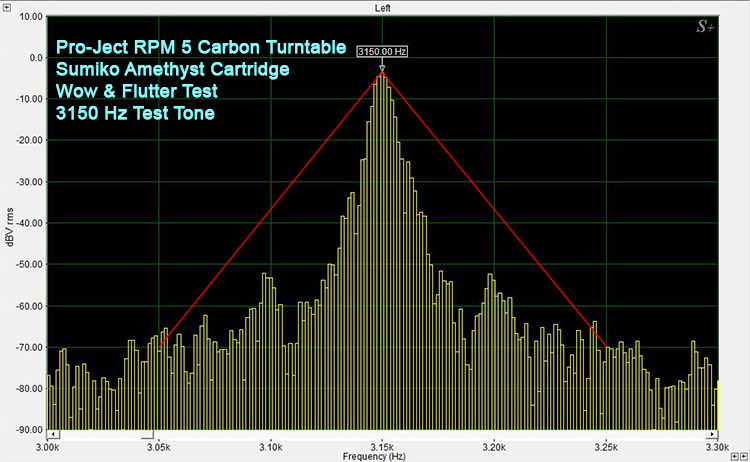
Pro-Ject RPM 5 Carbon /Sumiko Amethyst Wow & Flutter Test
The 33-1/3 RPM Wow & Flutter test, above, shows barely any flutter at the extreme end of the spectrum which is outside the imaginary diagonal line that would be drawn from the peak down to the 3,050 Hz point and 3,250 Hz point.

The PRO-JECT RPM 5 CARBON TURNTABLE is a beautiful and elegant piece of audio design. The Sumiko Amethyst cartridge, however, was not quite for me.
- Beautiful avant-garde design.
- The carbon fiber tonearm looks slick!
- Extremely solidly built.
- Revised cueing arm/tonearm travel.
- For the price, include the lid but let me choose my own cartridge.
The Pro-Ject RPM 5 Carbon is an interesting and desirable choice for a turntable in its price class. It makes a bold and beautiful visual statement; it is solidly built and not too difficult to set up and maintain. It also has all the necessary adjustments one needs to dial in its performance properly and precisely. As a belt-driven turntable, there is little to fault with it. I am less positive, however, on the bundled phono cartridge. Subjectively and objectively, the Sumiko Amethyst is a bit of a mixed bag. It’s more forward audio presentation and great bass response, for me, worked better with Jazz, Rock and Blues music. When we got to complex classical music, the boosted upper-end response and distortion/tracking performance made me like it less compared to my reference system. Musical tastes being what they are, I’m sure the Amethyst is voiced for a particular listener, and there may be many who’ll find it’s sound to their liking. Sad to say that this listener is perhaps not one of them.


